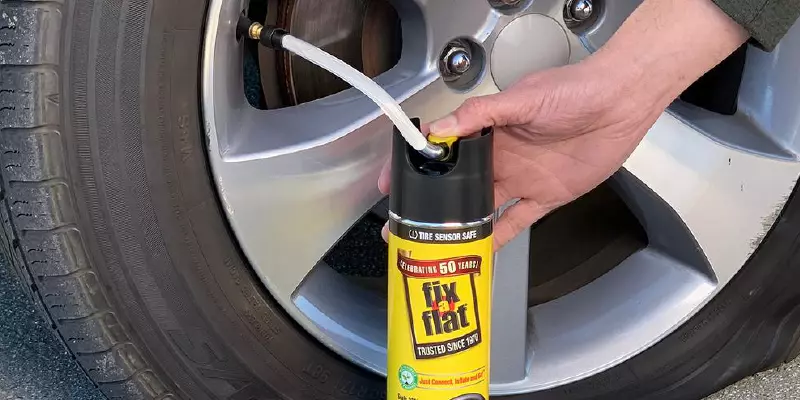Slow tire leak is quite a headache for all of us. The inconvenience of losing tire pressure while driving and getting stranded on the road is unimaginable. Many innovations are promising to address slow leaks like the fix-a-flat. Does fix-a-flat work on slow leaks?
Fix-a-flat works on the puncture-related cause of slow leaks. The sealant can temporarily mend small punctures in tires caused by nails or any sharp objects. It will allow you to run a few more miles until you get to a repair shop for a permanent fix.
However, if the slow leak is because of a valve issue, fix-a-flat could not help. In this scenario, you would probably need other tools like a valve stem tool to fix the problem.
Read on because I will elaborate on how fix-a-flat works on slow leaks and provide other relevant information to help you understand its mechanism.
How To Fix a Slow Leak in a Tire
A slow leak is an issue wherein the air in your tire gradually decreases while driving or when you check your vehicle in the morning, and you keep adding up air to put it back to the normal pressure.
How does this happen? There are numerous causes of slow leaks, including a tiny puncture, wheel damage, and valve stem damage.
Fix-a-Flat
The most popular easy and quick solution is fix-a-flat. It is a convenient solution as you can stock a couple of cans in your trunk and find them when you need them. The process of using fix-a-flat is also relatively easy.

However, many tire users regret using fix-a-flat because of bad experiences. Some say that it completely damaged the tire.
So, is it going to do more damage than help? Well, it depends. If you do not follow the usage instruction, it might damage your tire. But it will help you go a few miles to get your tire repaired.
You should note that fix-a-flat is not a permanent fix for slow tire leaks. The intervention of a professional repair person is necessary for a 100% solution.
As a temporary fix, a fix-a-flat is an easy solution to keep you going for more miles until to get some professional help from tire repair shops. However, this band-aid solution does not work all the time. As mentioned earlier, the sealant is not capable of fixing leaks coming from the tire’s valve.
Fix-a-flat may also not seal leaks located on the sidewall of the tire. If your car tire becomes flat and the fix-a-flat is not working, you might need to call a towing company.
Furthermore, the sealant may also not fix previously repaired areas of the tire.
Plug or Patch
Another possible fix for a slow leak is the easy-to-use tire plug or patch kit. This plug or patch technique is also an effective way of fixing a slow leak on your tire. However, this is also a temporary solution like the fix-a-flat.
Tire experts argue that you cannot consider plug or patch as a permanent solution to a slow leaking tire simply because it does not seal the tire’s inner liner, and it does not fix the void left on the tire by the penetrating object.
Curing at Tire Repair Shops
Tire repair shops have experts capable of permanently fixing your slow leaking tire to make it safe to drive again through rubber curing.
However, it is essential to note that not all tires are repairable. There will be cases that a complete tire replacement is required to ensure your safety and convenience.
How Long It Takes for a Fix-a-Flat to Harden?
Generally, the fix-a-flat sealant does not harden inside the tire – it stays as a thick liquid. How it works is: it fills the micro holes of your tire (approximately less than 1/4 inch) to block the air popping out of your tire.
So, the real question is, how soon can you use the tire after applying fix-a-flat?
Fix-a-flat contains both liquid sealant and air to allow you to drive again instantly. The liquid sealant plugs holes less than 1/4 inch and coagulates pretty immediately, making it an instant solution.
Fix-a-flat sealant can damage your tire if you keep it for a long time. You need to remember that this is a temporary fix, and it is to allow you to drive for at least 100 miles or about three days and get your tire permanently fixed.
Dried up fix-a-flat kept in the tire for so long can cause the rubber to break down completely. In addition, if the sealant stays very long inside your tire, it will potentially cause corrosion on the metal parts of the tire or the rim.
Is Fix-a-Flat Safe for Tire Pressure Monitoring Sensors (TPMS)?
First off, what is Tire Pressure Monitoring Sensor? It is an electronic system that monitors the tire air pressure to pressure up your tire immediately when the pressure goes low.
A TPMS can be direct or indirect. Direct TPMS is the one that mounts directly on the valve stem (this is the TPMS we are talking about). The indirect TPMS is the one that works with the Antilock Braking System’s (ABS) wheel speed sensors. The latter is never affected by fix-a-flat.
Fix-a-flat is TPMS safe, or at least, that is what they suggest. The device should work with no issues as long you clean the sealant away. After a professional service to repair your tire, you can clean your TPMS using water. You can reset the TPMS to resume to a working state when the tire is ready to roll.
However, we should not limit the possibility that the sealant will permanently damage the tire pressure monitoring system, but the chance is very slim.
While you have the fix-a-flat inside the tire, it can be understood if the TPMS will temporarily not provide accurate information. The sealant will surely mess up the pressure monitoring system. However, after a thorough cleaning and possibly resetting the system, it should go back to its normal working state.
The question is: Does the car repair shop handle the cleaning? The answer could be a yes, but not for free. It is a taxing job, so in most cases, repair shops charge a certain amount of money to do it for you.
Can You Use Fix-a-Flat on the Same Tire Twice?
It is okay to use fix-a-flat on a tire that you previously used it on. The tire shop will clean up the tire properly before curing the rubber to fix the slow leak permanently. As long as the tire is well-cleaned, you can use fix-a-flat again on the tire to address future slow leaks emergencies.
However, as mentioned earlier, fix-a-flat may not work on the tire’s repaired area.
You probably also want to know how much fix-a-flat to pump into your tire. You must empty the can of fix-a-flat in one go and one single tire. That is how fix-a-flat works and failure to follow the procedure may not deliver the performance you expected.
If it is not apparent yet, you cannot reuse fix-a-flat. Thus, to be ready for another instance of a slow leak, take a couple more extra fix-a-flat in your vehicle.
I must reiterate that you only resort to using fix-a-flat when you don’t have any other option. If you have a spare tire and you know how to mount it, or you have access to someone who knows how to replace the tire, it would be the best option.
Why do you need to avoid fix-a-flat when you can? It is because of the few disadvantages that may not be very economical.
How Long Fix-a-Flat Lasts?
Fix-a-flat allows you to drive for at least 100 miles or up to 3 days. Given that the application is correct. The video from O’Reilly Auto Parts YouTube channel is an actual demonstration of how to use fix-a-flat.
I will repeat, using fix-a-flat should be for emergency purposes only or a situation of “no other choice.” Most users of fix-a-flat don’t realize that they must repair the tire with a slow leak as soon as possible. The reason for this is to get rid of the sealant and avoid potential damages to the tire.
Users of fix-a-flat think that it is a permanent solution as it may effectively block the tire’s air. But it will never be a permanent solution as you will potentially damage your tire. Money-wise, it will be more expensive to replace your tires than to get them fixed.
As far as its shelf-life is concerned, fix-a-flat lasts two years from the manufacturing date. However, storage and temperature may have some effects on how long fix-a-flat is suitable for use.
Conclusion
Fix-a-flat temporarily fixes slow leaks by sealing micro holes or holes that are less than 1/4 inch. It may not work if the slow leak is on the tire’s stem valve.
It is an immediate solution to allow you to run for another 100 miles to get your tire repaired by a tire repair professional. The tire shop professional will do the tire cleaning and will fix the tire permanently when possible.
A couple of cans of fix-a-flat is worth keeping in your car’s trunk. They can save you from getting stranded helplessly in the middle of the road.


